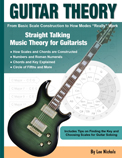Chord Basics
Two notes played simultaneously are referred to as intervals. Three or more notes played simultaneously are referred to as chords.
Chords consisting of three notes are known as triads. Chords consisting of four or more are known as extended chords (more on this a bit later.) Regardless of the amount of notes, they all share one thing in common. They are built from their associated major scales and stacked in thirds, which is the same thing as every other note in the scale. If you are new to all of this then that might sound complicated so let's break it down.
In the previous lesson we looked at how scale notes are numbered from one to seven. If we want to go further than just one octave then we can carry on with the numbering system by starting over again past the seven, as shown in the example below. The C major scale is used here for reference but it doesn't matter what scale you use, the same principle still applies..

This method of counting only up to seven is the one that makes the most sense in most cases, however when it comes to understanding the way we create chord names, it's best to temporarily ignore it and just use a numbering system that carries on through the octave, like this...

Hint: You've heard of chords like D9, C11, F13 etc.. right? Ever wondered where the numbers come from? This numbering system should start making sense very soon!
Okay let's move on. Earlier I mentioned that chords are built from the major scale by stacking notes in thirds. This isn't the same thing as third intervals, (that's for another lesson) for now let's just be clear that when we say chords are built in thirds from the major scale, what we really mean is every third note in the scale starting from, and including, the root note. You could also just think of it in terms of every alternate note. A picture says a thousand words so take a look at the example below.

Kindle book available from Amazon
Guitar Theory: Available on Kindle
Learn music theory that's worth knowing
Music theory can be complicated but we need to know it if we want to make sense of everything and improve our guitar knowledge and playing.
My latest book focuses mostly on the things that are really worth knowing, not so much on the rest. Start making sense of chords, scales, modes and finding the key to help you be more creative on the guitar.
Level: Advanced beginner and up.
Author: Lee Nichols Creator of www.guitar-chords.or.uk
(Sponsored Ad)
This website earns advertising commissions. To find out more about cookies, privacy and how we use advertising, please read our Advertising Disclaimer
Contact Info - Cookie and Privacy Policy
Copyright © 2007 - 2024 www.guitar-chords.org.uk


